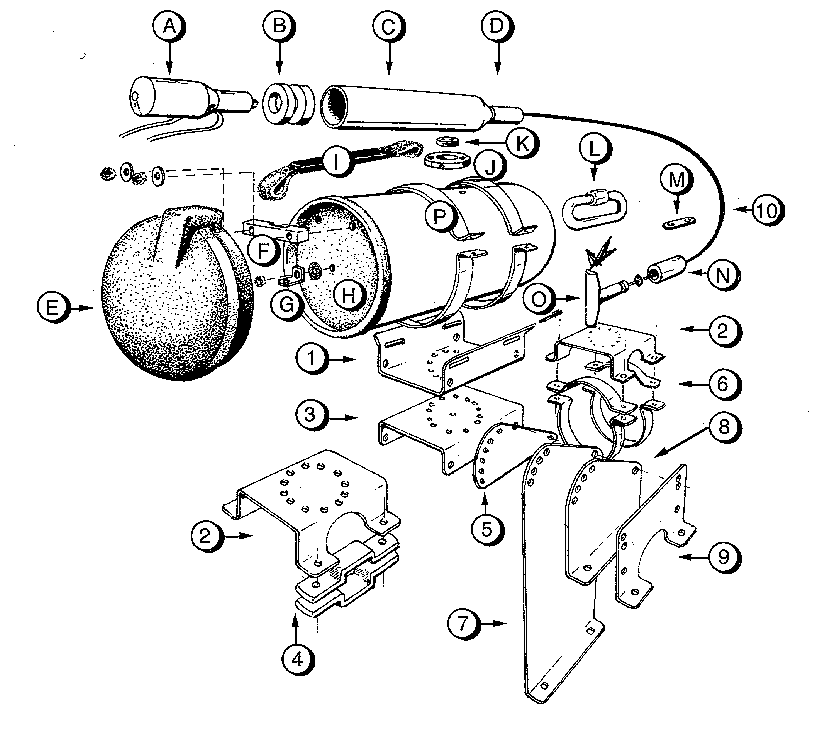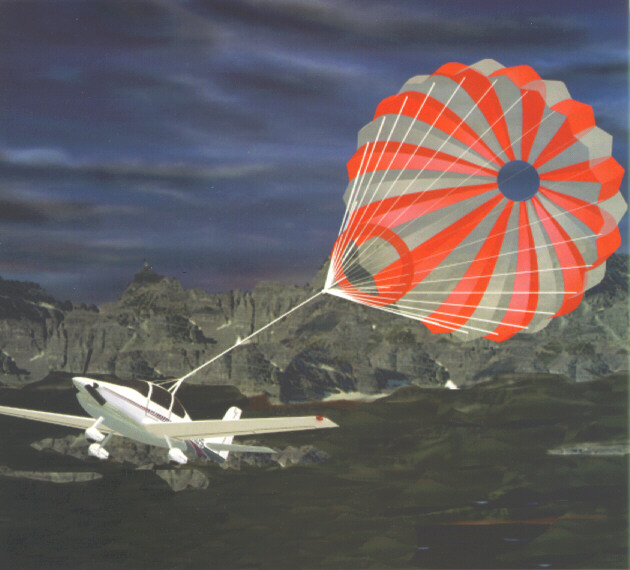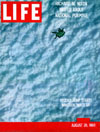Drop Zone Press
Drop Zone Press provided historically interesting information regarding emergency parachutes for planes, among other esorteric bits of news. This version of the original site was restored as reference material for Willem Marell's lecture series The History of Flight Safety. The Web Archive Project provided funding for the restoration of this historically significant document. TNG/Earthling's Bob Sakayama provided pro bono technical assistance and Rev Sale handled content curation and research.
Content is from the site's 1997 archived pages.
You have to admit this is a rather esoteric site. I have just started pilot training. And I must admit, even with all the safety features now available I still find myself thinking about scenarios where a parachute would save my life. As an expert in Salesforce implementation I travel by plane to visit many clients. Being able to fly my own plane would be a convenient and cost-effective method of travel. I can set my own schedule, use airports that airlines don't serve and leave the hassles of security lines behind. For business use, I believe flying my own plane would allow me to do more in one day than I could do in a week traveling by airline. Flexibility, privacy, and freedom are all great reasons these flight schools give to entice a customer to take lessons. I'm all in. And just in case, I am also taking parachute jumping lessons. You never know!!
![]()


![]()
Circa 1997
Editor's Note: The following article was written over 67 years ago.
We are still waiting for commercial passenger planes to have parachutes (parafoils).
LANDING AN AIRPLANE BY PARACHUTE
NOW that I have demonstrated that an airplane may be landed by a parachute I believe that the time is near when every up-to-date plane will be equipped with a mechanically released, built-in parachute. By this means a crippled-in-the-air-plane may be landed safely saving the entire load of passengers, pay load and the airplane from wrecking.
It requires no stretch of imagination to visualize every airplane of the near future with a built-in parachute snugly stored in the center wing section in such a way that no evidence is in sight of the latest safety device. Neither will the lines of the plane have to be changed. It has demonstrated that parachutes can be and are being used to land individual passengers safely. It is only a step further to apply the same safety device to a group and to the airplane.
It was only after many experiments with parachutes and weights and much study as to air resistance and other conditions entering into the project that I landed the first airplane by aid of a mechanically released built-in parachute. Had I not been confident of success I would never have tried it before 15,000 spectators in Santa Ana, California. Now that the initial test has proven so successful I look for rapid development along this line of safety first.
In this particular instance the result was accomplished by replacing the second rib on each half of the wing with a heavy plywood to take all the compression strain of the two ribs in general use. A steel rib was placed at the center section of the two half wings and the whole compartment thus created was floored with heavy ply wood. This gave greatly increased strength to the wing and at the same time afforded a solid compartment for the pack.
At each of the four corners of the compartment a heavy coil spring was placed, also two at the center. Each spring had a recoil force of 12,000 pounds and was placed in a solid steel container bolted through the spars.
By this arrangement the released shock was equally distributed and a force of 2,000 pounds thrown against the pack at the release of the springs.
On top of the six springs rested the basket which was the parachute carrier. The basket was of heavy fabric webbing strips around a flexible steel frame. To load the parachute into the compartment, it was folded on top of its connecting cables in the center of the carrier which was then placed on top of the springs. Over the whole was placed a cover of ply-wood shaped to conform with the wing curve. In the cover were openings to fit over spring-locking devices. Thus in place, jack-screws were brought into use and the whole forced down into the compartment until the coil-springs were sent down to be caught by the triggers which held them until released by the pilot.
The trigger release was mounted on ball bearings to eliminate as far as possible all friction and afford a quick release. Connected with the springs were six synchronized levers attached to a cable running down the inside of the right center strut to the pilot's cockpit. The cable was attached to a lever on the instrument board. To release the parachute the lever was moved from left to right and the six springs were released simultaneously. At the same moment, the trigger released the fastenings on the cover of the compartment. The force threw the parachute well clear of the plane thus avoiding entanglement with the rudder.
The parachute may be of any standard make and of size in proportion to the weight of the plane and load. The one used in my test at Santa Ana, California, was a Russell Valve type, 60 feet in diameter with an effective lift of 1,600 square feet. It was made of the heaviest parachute silk and had 60 silk shroud lines, each of 400 pounds tensile strength. Each shroud line measured 60 feet from lip of the parachute to the Dee rings, of which two were used, this precaution to help stop oscillation of the parachute.
The airplane was attached to the shroud lines from the parachute by four flexible cables running from the bottom longhorns at the two main stanchions up through the wing. Between these cables and the shroud lines of the parachute a connecting link was arranged that it could be released by the pilot on landing-- this to provide against the plane being dragged in case of strong wind.
Two days before the exhibition test a preliminary one was made from a straight flying position with the motor turned on. A load of papers of the weight of the parachute was used. From that test I saw that there was danger that the huge parachute, much heavier than the individual pack, might envelope both the tail and the pilot's cockpit and render escape impossible. To reduce this danger to a minimum I had the extra steel cables added to get more distance between the plane and the shroud lines. The extra length of cables was used for the first time in the exhibition at Santa Ana.
At this test a three-place biplane was used. So far as the spectators could see it was the regulation biplane as there were no visible evidences of the parachute. I circled over the airport gaining altitude, also making observations as to wind currents and possible drift.
After a few maneuvers I selected the most desirable position and pulled the release lever at the same time side-slipping the plane a little. Hurled by 12,000 pound force the great parachute came out of the compartment thrown well clear of the tail. It took form almost instantly bringing the plane into a combination loop and wing-over at right angles to the arc of the parachute-pulling shroud lines, and the mammoth billows of silk settled down slowly earth-ward with plane and pilot.
E. H. Dimiry, head of the Aircraft Safety Equipment Corporation, says "All manufacturers of airplanes, for all purposes, are using every effort to provide the greatest possible safety. The greatest drawback to air travel today is fear on part of the public. Once this is overcome, they will all take to the air as they have during past few years to automobiles. I believe that the day is near at hand when every passenger plane... will be equipped with built-in parachute, either the same or along the lines of the one used by Captain Turner in his experiment at Santa Ana. This is the day of progress in aircraft."
IMAGES of ROSCOE TURNER IN DESCENT
ROSCOE TURNER'S PLANE IN DECENT WITH PARACHUTE




PLANE AT A FEW HUNDRED FEET FROM GROUND


ALMOST DOWN


ROSCOE HAS A SAFE LANDING IN 1929

ROSCOE'S PARACHUTE DRAPES HIS PLANE

ROSCOE AFTER LANDING



ROSCOE WITH HIS LION CUB



ROSCOE'S PLANE GILMORE, NAMED AFTER HIS LION CUB

BRS-5
The Fifth Generation of BRS Life-Saving Technology


BRS UNIT HARDWARE:
A - Rocket Motor
B - Phenolic Washers
C - Launch Tube
D - Housing Cone
E - Outer Cap
F - Bridle Clamp
G - Rocket Lanyard Attachment
H - Inner Cap
I - Riser Extension
J - Rocket Pedestal
K - Rocket Disc
L - Link
M - Handle Plate
L - Phenolic
M - Rocket Motor
N - Handle Holder
O - Activating Handle
P - Canister BandsBRS-5 MOUNTING HARDWARE:
1 - Modular Mount
2 - Flat Sideplate
3 - Swivel Sideplate
4 - Mount Plates
5 - Triangular Sideplate
6- Mount Bands
7 - Tall Sideplate
8 - Regular Sideplate
9 - Short Sideplate
10 - Activating Housing
Note: Part numbers and names may be changed without notice.
LIGHT PLANE LANDING WITH PARACHUTE

CIRRUS DESIGN SR20
The world's first production line aircraft with an emergency parachute.
The SR20 uses a 55 foot diameter dome chute, manufactured by BALLISTIC RECOVERY SYSTEMS INC.(BRSI).
Press Release

June 14, 1996
TO: ASSIGNMENT EDITORS
FROM: MEDIA EVENTS INC.
RE: SAFETY PARACHUTES FOR DISTRESSED AIRCRAFT CONTACT:
DWIGHT CASIMERE (CLTV NEWS Reporter) -
Cell phone: 1-773-617-1695
DEAR EDITOR:
SEVEN YEAR OLD JESSICA DUBROFF, WHOSE LIGHT PLANE CRASHED IN WYOMING ATTEMPTING TO BECOME THE YOUNGEST PERSON TO EVER FLY SOLO ACROSS THE COUNTRY, NEED NOT HAVE DIED, IF HER PLANE HAD BEEN EQUIPPED WITH A RELATIVELY NEW, FAA REGISTERED TECHNOLOGY OF SAFETY PARACHUTES FOR SMALL AIRCRAFT.
THE SAME TECHNOLOGY IS ALSO APPLICABLE TO LARGER, COMMERCIAL AIRCRAFT, THROUGH THE USE OF TOP-LOADED, FLUSH MOUNTED EJECTABLE PARAFOILS, IN A PROPOSED AIR SAFETY SYSTEM BY ROY T. MALONEY OF SAN FRANCISCO.
MALONEY IS THE AUTHOR AND PUBLISHER OF FIVE BOOKS. HE DID SOME OF THE EARLY WORK ON COMPUTER-MICROFILM INTERFACING AND CREATED THE WORLD'S FIRST THREE-DIMENSIONAL MAGNETIC VARIATION GLOBE.
HE HAS MET WITH FIVE ASTRONAUTS AND WORKED FOR FIVE YEARS ON A NEW DEAD ROCKONING SYSTEM, FOR CELESTIAL NAVIGATION. IT USES THE ANALEMMAS OF ALL PLANETS.
HIS SYSTEM WAS CONFIRMED WITH THE ASSISTANCE OF RICHARD F. GORDON, JR., THE COMMAND MODULE PILOT ON APOLLO 12, THE SECOND LANDING MISSION TO THE MOON.
HE IS A FORMER PARATROOPER WHO LED THE FIRST MASS NIGHT AND DAY JUMPS IN YAMOTO, JAPAN DURING WORLD WAR TWO.
"THIS SYSTEM MAY HAVE SAVED LIVES IN THE RECENT VALUJET CRASH IN THE FLORIDA EVERGLADES. BY SIMPLY PULLING A LEVER, A PILOT COULD HAVE RELEASED FIVE PARAFOILS IN THREE SECONDS. THESE PARAFOILS COULD THEN HAVE ASSISTED THE DISTRESSED AIRCRAFT GLIDE IN MAKING A SOFT LANDING." MALONEY EMPHASIZED.
AS A FORMER PARATROOPER WITH THE 11TH AIRBORNE, MALONEY IS WELL AWARE OF THE LIFE-SAVING CAPABILITIES OF "PERSONNEL DECELERATORS" OR PARACHUTES. THE APPLICATION FOR LARGE AIRCRAFT IS SIMPLE.
"A 747 COULD HAVE FIVE PARAFOILS, THREE EQUALLY SPACED ON THE FUSELAGE AND ONE ON EACH WING. IF THE PLANE BEGINS A SUDDEN DESCENT, THE PILOT WOULD PULL A FORTY POUND LEVER AND RELEASE THE CHUTES, WHICH WOULD THEN SLOW DOWN THE DESCENT. THE PLANE WOULD HAVE A CHANCE TO GLIDE AND LAND, LIKE A "CREAM PUFF.
" IF YOU KNEW YOUR PLANE WAS GOING DOWN, MALONEY ASKED. "WOULDN'T YOU WANT THE OPTION TO SLOW THE DESCENT?
" MOST OF THE OBJECTIONS TO USING CHUTES ON COMMERCIAL AIRLINES CENTER AROUND COST, WEIGHT, GOVERNMENT APPROVAL AND THE ABILITY OF THE AIRCRAFT AND THE CHUTE TO WITHSTAND SHOCK.
FROM AN ECONOMIC STANDPOINT, IF EMERGENCY CHUTES COULD SAVE ONE COMMERCIAL AIRLINER PER YEAR, IT WOULD SAVE MILLIONS IN LITIGATION COSTS. "TURNING ONE HUNDRED FIFTY MILLION DOLLAR PLANES INTO LITTLE SCRAPS OF TWISTED METAL CAN BE VERY EXPENSIVE," MALONEY SAID.
THE ADDITIONAL WEIGHT AND VOLUME OF THE FIVE PARAFOILS WOULD REPRESENT A LOSS OF TWO PASSENGERS, AT MOST, MALONEY THEORIZED. COSTS COULD BE AMORTIZED IN ONE OR TWO YEARS. IF ONE PLANE IS SAVED, PAYING CUSTOMERS COULD DETERMINE THE BOTTOM LINE. "IN SHORT, THE FIRST PLANE THAT MAKES A SOFT LANDING THROUGH USE OF CHUTES AND HAS SURVIVORS INSTEAD OF BODIES SCATTERED ACROSS THE LANDSCAPE OR AT THE BOTTOM OF A SWAMP, WOULD GAIN INCREASED GOODWILL AND GREATER SALES FOR THE AIRLINE.
SAVING LIVES IS THE STRONGEST PUBLIC, RELATIONS STATEMENT AN AIRLINE CAN MAKE."
MR. MALONEY HAS A SCALE-MODEL OF THE PARAFOIL SAFETY SYSTEM, SKYHOOK 5, FOR COMMERCIAL AIRLINES IN HIS OFFICE.

HE HAS MET WITH FIVE ASTRONAUTS AND WORKED FOR FIVE YEARS ON A NEW DEAD RECKONING SYSTEM, FOR CELESTIAL NAVIGATION. IT USES THE ANALEMMAS OF ALL PLANETS.

Press Release
SKYHOOK 5
DROP FROM 30 MILES
DROPZONE
NOV 22, 1996
TO: ASSIGNMENT EDITORS, SENIOR PRODUCERS
From: DWIGHT CASIMERE (CLTV NEWS Reporter)
Cell phone: 1-773-972-3236
RE: PARACHUTE SAFETY SYSTEM FOR COMMERCIAL AIRLINES
A SAN FRANCISCO MAN IS PREPARING TO MAKE A WORLD RECORD PARACHUTE JUMP AS A MEANS OF DEMONSTRATING THE FEASIBILITY OF PARACHUTES AS A SAFETY MECHANISM FOR DISTRESSED COMMERCIAL AIRCRAFT.
ROY T. MALONEY, A FORMER PARATROOPER, PLANS TO MAKE THE JUMP FROM A HEIGHT OF 30 MILES. THE PROCEDURE WILL INVOLVE A BALLISTICALLY DEPLOYED MINI-SPACE CAPSULE THAT WILL CONTAIN A VELOCITY CONTROLLED, BAROMETRICALLY RELEASED PARACHUTE. AFTER IT IS RELEASED FROM A SPACE CAPSULE, MALONEY THEN HAS THE OPTION OF JUMPING FROM THE CAPSULE, OR LANDING WITH IT.
"I PLAN TO SHOW THAT PARACHUTES ARE A VIABLE SAFETY DEVICE UNDER EXTREME AVIATION CONDITIONS. BY SETTING WORLD RECORDS FOR THE HIGHEST PARACHUTE JUMP, THE LONGEST FREE FALL AND THE FASTEST HUMAN WITHOUT MECHANICAL MEANS, I INTEND TO PROVE THAT PARACHUTES CAN BE USED TO SAVE LIVES WHEN USED ON SOPHISTICATED AIRCRAFT WHEN APPLIED IN STRATEGIC MANNER."
MALONEY SAYS HE HAS NO PLANS OF SETTING A FOURTH RECORD, NAMELY LONGEST FREE FALL WITHOUT PARACHUTE.
A SIMILAR FEAT WAS ACCOMPLISHED IN 1960 WHEN COL. JOSEPH KITTINGER MADE A FREE FALL OF OVER 16 MILES FROM THE GONDOLA OF A HOT AIR BALLOON, POSITIONED NEARLY 20 MILES ABOVE THE EARTH. MALONEY BELIEVES HE CAN DEMONSTRATE A POSSIBLE EMERGENCY SAFETY PROCEDURE FROM A SPACE SHUTTLE FOR OPTIONAL USE BY ASTRONAUTS.

"BY REALIZING THE FULL POTENTIAL OF PARACHUTES AS A SAFETY MECHANISM, THE LOSS OF LIFE IN AIR DISASTERS CAN BE MITIGATED. PILOTS OF DISTRESSED AIRCRAFT WILL HAVE AT THEIR DISPOSAL AN EMERGENCY PARACHUTE SYSTEM (EPS), ALLOWING THEM TO GLIDE-PATH LAND TROUBLED AIRPLANES LIKE A CREAM PUFF, SIMPLY BY PULLING A HANDLE, OR HANDLES AND RELEASING A SERIES OF PARACHUTES STRATEGICALLY PLACED ON THE AIRCRAFT...USING UP TO 5 PARAFOILS ON A 747, OR COMMERCIAL AIRLINER."
"MODULAR PARAFOILS (WING PARACHUTES) CAN BE ZIPPERED TOGETHER, TO FORM ANY SIZE, FOR ANY APPLICATION."
"THE OPTION OF PULLING A 45 POUND HANDLE IS PREFERRED TO TURNING A MULTI-MILLION DOLLAR COMMERCIAL AIRLINER INTO LITTLE BITS OF CHARRED METAL, ESPECIALLY CONSIDERING THE LOSS OF LIFE," MALONEY SAID.
HE IS NOT INTERESTED IN FINANCIAL GAIN, OR SELLING A PRODUCT, ONLY IN SAVING LIVES AND VISIBILITY FOR THE SYSTEM.
MALONEY HAS ALREADY GAINED PRAISE FROM RESPECTED MEMBERS OF THE AIRCRAFT INDUSTRY, PETER A. JOHNSON, A FORMER AIRCRAFT CARRIER PILOT AND AIRCRAFT CONSULTANT WITH DIXVILLE NOTCH CONSULTANTS, INC. IN CAMPTON, NEW HAMPSHIRE SAYS "YOUR SYSTEM COULD VERY WELL BE A GENERIC SOLUTION TO THE AIRCRAFT INDUSTRY."
JAY WILLMOTT, VICE PRESIDENT, BAI AEROSYSTEMS INC., LEADERS IN THE WORLD FOR UAV'S SAYS, "I BELIEVE YOUR SYSTEM OF CHUTES FOR A 747 MAKES SENSE, SINCE WE ARE ALREADY USING PARAFOIL CHUTES ON THE WING OF OUR UNMANNED AERIAL VEHICLES."
More Background On DropZonePress.com
DropZonePress.com is an intriguing digital archive focused on the fascinating and often underappreciated field of emergency parachutes and aviation safety systems. Far from a typical aviation enthusiast site, DropZonePress.com preserves history, promotes innovation in flight safety, and documents advocacy for technology that has saved—and could save—countless lives. This article offers a thorough introduction to the site, unpacking its origins, purpose, content, audience, cultural significance, technical insights, and its role in shaping ongoing conversations about air safety.
Ownership, Management, and Restoration
DropZonePress.com is not a commercial enterprise but operates as a historic preservation project. The restoration and maintenance of the site reflect a group effort:
-
Restoration and Funding: The Web Archive Project funded the site’s resurrection, recognizing its value as a historic document and reference for aviation safety.
-
Technical Oversight: TNG/Earthling provided pro bono technical support, ensuring that the site's structure and archival integrity were maintained.
-
Content Curation: Rev Sale undertook the task of researching and curating content, assembling materials spanning multiple decades.
-
Academic Support: The site serves as reference material for lecture series such as Willem Marell’s “The History of Flight Safety.” It has also been preserved for scholarly and educational use.
There is no evidence of a corporate owner; instead, stewardship lies with individuals passionate about aviation history and safety.
Digital Location and Context
DropZonePress.com exists entirely in the digital realm, making its information globally accessible to researchers, students, and hobbyists. Its American contributors and subject matter give it a clear U.S. leaning, but its relevance is international.
Site Mission and Goals
DropZonePress.com is guided by several objectives:
-
Preservation: Protect and digitize historical documentation, making century-old aviation safety research available to modern audiences.
-
Education: Provide materials and stories to instructors, students, and researchers learning about the evolution of parachute systems.
-
Advocacy: Publicize the benefits and technical feasibility of emergency parachute systems—and prompt debate about why such technology isn’t standard in commercial aviation.
-
Community Reference: Serve pilots, aviation students, designers, and innovators as a deep reference point for emergency landing technologies.
Core Content and Highlights
The distinctive value of DropZonePress.com comes in the breadth and depth of its historic and technical material, much of which is rarely found elsewhere. Here’s a deeper look at its main offerings.
1. Historic Narratives
DropZonePress.com houses detailed accounts from both contemporary and archival sources that trace the development of emergency parachuting concepts:
-
1929 Parachute Landing Demonstration: A recount of a groundbreaking event at Santa Ana, California, shows how an aircraft was safely landed using a built-in, mechanically released parachute system. The piece walks through the design challenges, mechanical details, risk mitigation strategies, and the spectacle witnessed by an audience of thousands. It documents how the parachute system was fitted to the airframe and how the pilot controlled deployment—pioneering work at a time when public fear overshadowed the promise of air travel.
-
Aviation Pioneers: The site features figures like Roscoe Turner, whose dramatic parachute descents—and even his famous lion cub Gilmore—gave a human face to technical innovation in the 1920s and 1930s. These stories combine technical description with the thrill and uncertainty of early flight.
2. Technical Innovations
DropZonePress.com excels in documenting the structure and function of emergency parachute systems:
-
Built-in Parachute Compartments: Detailed engineering notes explore how built-in airplane parachutes might be housed in reinforced compartments, launched using synchronized springs, and controlled by the pilot.
-
Skyhook 5 Emergency Parafoil System: This advanced concept involves multiple parafoils for large airliners, theoretically enabling a crippled commercial jet to descend gently (“like a cream puff”).
-
Ballistic Recovery Systems (BRS-5): Exhaustive breakdowns of the fifth generation of BRS technology include rocket deployment motors, riser extension mechanisms, and modular mounting gear—showcasing the move from prototype to production for new general aviation airplanes.
-
Cirrus SR20: The site notes this aircraft as the first production plane with a factory-installed emergency parachute, marking a watershed moment in commercial safety standards.
3. Advocacy and Case Studies
The site’s editorial stance is clear: it argues that the technology to make all aircraft fundamentally safer has long existed, yet industry-wide adoption lags due to regulatory, commercial, and technical inertia.
-
Jessica Dubroff Crash: The tragic accident involving young aviator Jessica Dubroff prompted renewed emphasis on the potential life-saving benefits of small aircraft parachutes.
-
Roy T. Maloney’s Proposals: Maloney devised modular parafoil systems designed for airlines such as the Boeing 747, proposing that only a few passenger seats’ worth of payload lost could yield massive safety benefits. Maloney’s work, blending practical experience as a paratrooper with technical insight, is presented as both feasible and revolutionary.
4. Press Releases & Media Coverage
DropZonePress.com includes various press releases addressing both the aviation and mainstream media, emphasizing:
-
The feasibility of parafoil systems for large commercial planes, including technical diagrams and rationale.
-
Planned world-record parachute jumps to demonstrate parachute performance from unprecedented heights (e.g., thirty miles above Earth, paralleling Col. Joseph Kittinger’s famed high-altitude experiments).
-
Opinions and endorsements from flight safety consultants, engineers, and industry insiders, highlighting how some in the professional community believe these systems could become the next leap in aviation safety.
5. Awards, Recognition, and Industry Reception
While DropZonePress.com itself is not an award-seeking entity—its preservationist and archival mission stands apart from commercial sites—it has received informal praise from aviation consultants and industry professionals. Notable testimonials on the feasibility of large-scale parafoil systems are included from respected carrier pilots, aircraft consultants, and aeronautical engineers, affirming DropZonePress.com’s role in shaping professional debate.
The Cirrus SR20, featured on the site, did gain major recognition for incorporating a BRS parachute as a standard safety feature—a development foreshadowed by the site’s advocacy work.
DropZonePress.com draws a specialized but passionate audience:
-
Primary Audience: Pilots, student aviators, aviation engineers, skydivers, and safety experts.
-
Secondary Users: Historians, journalists, and researchers investigating aviation safety.
-
Aspirational Flyers: Individuals learning to fly—many of whom, as evidenced by site commentary, weigh the real risks of flight and seek safety instruction in both flying and parachuting.
The site's overall popularity is modest by mainstream standards but significant in its field. Its survival and restoration indicate a quiet but persistent demand for the kind of deep, technically informed history and advocacy it provides.
Cultural and Social Significance: By highlighting both historic and modern arguments for parachute-equipped aircraft, the site contributes to an ongoing societal conversation about risk, innovation, and regulatory change in aviation. Its stories of innovation, tragedy, and advocacy highlight the balance between technological progress and the inertia of established practice.
Insights, Specifics, and Examples
-
Mechanical Detailing: Technical descriptions on DropZonePress.com delve into the proper calibration of spring recoil forces, the geometry of storage compartments, and the triggering mechanisms required to ensure reliable, tangle-free parachute deployment.
-
Human Drama: The narrative is filled with human stakes—from daredevil pilots risking career and life to prove a theory, to technical experts like Roy Maloney, whose war service and scientific ambition led him to challenge aviation orthodoxy.
-
Feasibility Arguments: Economic analysis included on the site demonstrates how the cost and weight of emergency parafoils on a 747 might replace only two passenger seats—while potentially saving everyone else aboard.
-
Industry Reaction: Statements from aviation and unmanned aerial vehicle experts support the argument that what has been possible for small and unmanned aircraft must now be scaled for commercial use.
DropZonePress.com is a singular, irreplaceable resource that covers not just the machinery of emergency parachutes but also their cultural, historical, and ethical dimensions. Through archival preservation, technical documentation, and a clear advocacy lens, the site makes both a scholarly and practical case for embracing safety innovations that could transform air travel. Though it does not court mass popularity, DropZonePress.com’s influence is palpable wherever the future of aviation safety is debated—and it stands as a testament to the enduring power of visionaries, advocates, and unsung heroes in aviation history.